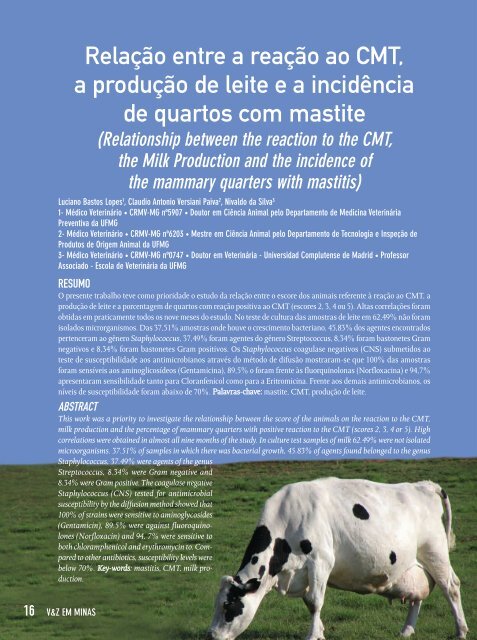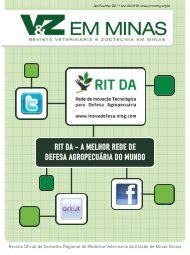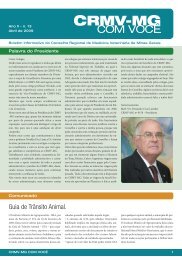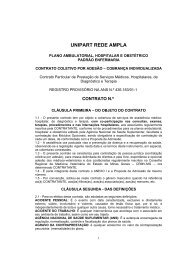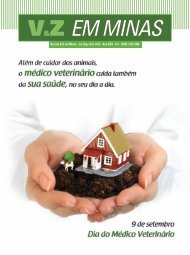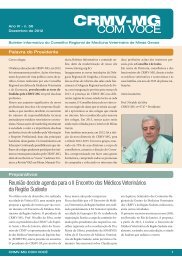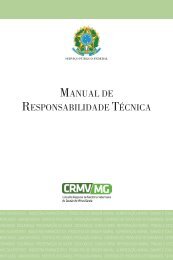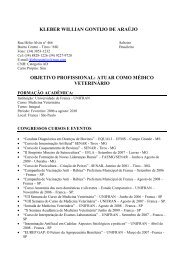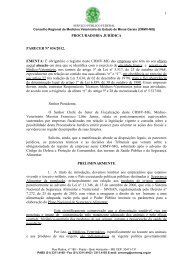Create successful ePaper yourself
Turn your PDF publications into a flip-book with our unique Google optimized e-Paper software.
16 V&Z EM MINAS<br />
Relação entre a reação ao CMT,<br />
a produção de leite e a incidência<br />
de quartos com mastite<br />
(Relationship between the reaction to the CMT,<br />
the Milk Production and the incidence of<br />
the mammary quarters with mastitis)<br />
Luciano Bastos Lopes1 , Claudio Antonio Versiani Paiva2 , Nivaldo da Silva3 1- Médico Veterinário • <strong>CRMV</strong>-<strong>MG</strong> nº5907 • Doutor em Ciência Animal pelo Departamento de Medicina Veterinária<br />
Preventiva da UF<strong>MG</strong><br />
2- Médico Veterinário • <strong>CRMV</strong>-<strong>MG</strong> nº6203 • Mestre em Ciência Animal pelo Departamento de Tecnologia e Inspeção de<br />
Produtos de Origem Animal da UF<strong>MG</strong><br />
3- Médico Veterinário • <strong>CRMV</strong>-<strong>MG</strong> nº0747 • Doutor em Veterinária - Universidad Complutense de Madrid • Professor<br />
Associado - Escola de Veterinária da UF<strong>MG</strong><br />
RESUMO<br />
O presente trabalho teve como prioridade o estudo da relação entre o escore dos animais referente à reação ao CMT, a<br />
produção de leite e a porcentagem de quartos com reação positiva ao CMT (escores 2, 3, 4 ou 5). Altas correlações foram<br />
obtidas em praticamente todos os nove meses do estudo. No teste de cultura das amostras de leite em 62,49% não foram<br />
isolados microrganismos. Das 37,51% amostras onde houve o crescimento bacteriano, 45,83% dos agentes encontrados<br />
pertenceram ao gênero Staphylococcus, 37,49% foram agentes do gênero Streptococcus, 8,34% foram bastonetes Gram<br />
negativos e 8,34% foram bastonetes Gram positivos. Os Staphylococcus coagulase negativos (CNS) submetidos ao<br />
teste de susceptibilidade aos antimicrobianos através do método de difusão mostraram-se que 100% das amostras<br />
foram sensíveis aos aminoglicosídeos (Gentamicina), 89,5% o foram frente às fluorquinolonas (Norfloxacina) e 94,7%<br />
apresentaram sensibilidade tanto para Cloranfenicol como para a Eritromicina. Frente aos demais antimicrobianos, os<br />
níveis de susceptibilidade foram abaixo de 70%. Palavras-chave: mastite, CMT, produção de leite.<br />
ABSTRACT<br />
This work was a priority to investigate the relationship between the score of the animals on the reaction to the CMT,<br />
milk production and the percentage of mammary quarters with positive reaction to the CMT (scores 2, 3, 4 or 5). High<br />
correlations were obtained in almost all nine months of the study. In culture test samples of milk 62.49% were not isolated<br />
microorganisms. 37.51% of samples in which there was bacterial growth, 45.83% of agents found belonged to the genus<br />
Staphylococcus, 37.49% were agents of the genus<br />
Streptococcus, 8.34% were Gram negative and<br />
8.34% were Gram positive. The coagulase negative<br />
Staphylococcus (CNS) tested for antimicrobial<br />
susceptibility by the diffusion method showed that<br />
100% of strains were sensitive to aminoglycosides<br />
(Gentamicin), 89.5% were against fluoroquinolones<br />
(Norfloxacin) and 94, 7% were sensitive to<br />
both chloramphenicol and erythromycin to. Compared<br />
to other antibiotics, susceptibility levels were<br />
below 70%. Key-words: mastitis, CMT, milk production.


